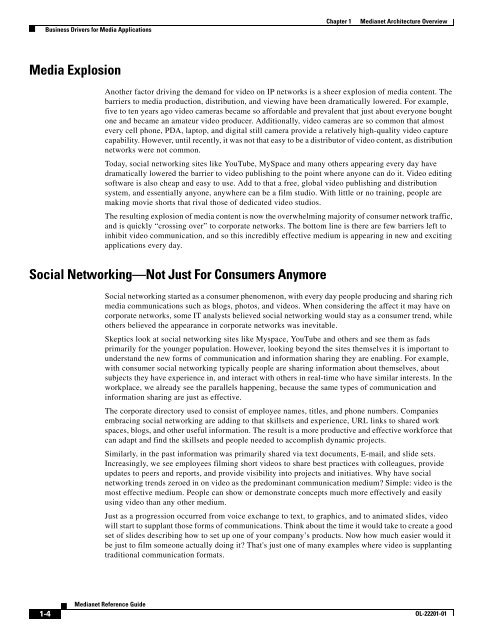Medianet Reference Guide - Cisco
Medianet Reference Guide - Cisco
Medianet Reference Guide - Cisco
Create successful ePaper yourself
Turn your PDF publications into a flip-book with our unique Google optimized e-Paper software.
Business Drivers for Media Applications<br />
Chapter 1<br />
<strong>Medianet</strong> Architecture Overview<br />
Media Explosion<br />
Another factor driving the demand for video on IP networks is a sheer explosion of media content. The<br />
barriers to media production, distribution, and viewing have been dramatically lowered. For example,<br />
five to ten years ago video cameras became so affordable and prevalent that just about everyone bought<br />
one and became an amateur video producer. Additionally, video cameras are so common that almost<br />
every cell phone, PDA, laptop, and digital still camera provide a relatively high-quality video capture<br />
capability. However, until recently, it was not that easy to be a distributor of video content, as distribution<br />
networks were not common.<br />
Today, social networking sites like YouTube, MySpace and many others appearing every day have<br />
dramatically lowered the barrier to video publishing to the point where anyone can do it. Video editing<br />
software is also cheap and easy to use. Add to that a free, global video publishing and distribution<br />
system, and essentially anyone, anywhere can be a film studio. With little or no training, people are<br />
making movie shorts that rival those of dedicated video studios.<br />
The resulting explosion of media content is now the overwhelming majority of consumer network traffic,<br />
and is quickly “crossing over” to corporate networks. The bottom line is there are few barriers left to<br />
inhibit video communication, and so this incredibly effective medium is appearing in new and exciting<br />
applications every day.<br />
Social Networking—Not Just For Consumers Anymore<br />
Social networking started as a consumer phenomenon, with every day people producing and sharing rich<br />
media communications such as blogs, photos, and videos. When considering the affect it may have on<br />
corporate networks, some IT analysts believed social networking would stay as a consumer trend, while<br />
others believed the appearance in corporate networks was inevitable.<br />
Skeptics look at social networking sites like Myspace, YouTube and others and see them as fads<br />
primarily for the younger population. However, looking beyond the sites themselves it is important to<br />
understand the new forms of communication and information sharing they are enabling. For example,<br />
with consumer social networking typically people are sharing information about themselves, about<br />
subjects they have experience in, and interact with others in real-time who have similar interests. In the<br />
workplace, we already see the parallels happening, because the same types of communication and<br />
information sharing are just as effective.<br />
The corporate directory used to consist of employee names, titles, and phone numbers. Companies<br />
embracing social networking are adding to that skillsets and experience, URL links to shared work<br />
spaces, blogs, and other useful information. The result is a more productive and effective workforce that<br />
can adapt and find the skillsets and people needed to accomplish dynamic projects.<br />
Similarly, in the past information was primarily shared via text documents, E-mail, and slide sets.<br />
Increasingly, we see employees filming short videos to share best practices with colleagues, provide<br />
updates to peers and reports, and provide visibility into projects and initiatives. Why have social<br />
networking trends zeroed in on video as the predominant communication medium? Simple: video is the<br />
most effective medium. People can show or demonstrate concepts much more effectively and easily<br />
using video than any other medium.<br />
Just as a progression occurred from voice exchange to text, to graphics, and to animated slides, video<br />
will start to supplant those forms of communications. Think about the time it would take to create a good<br />
set of slides describing how to set up one of your company’s products. Now how much easier would it<br />
be just to film someone actually doing it? That's just one of many examples where video is supplanting<br />
traditional communication formats.<br />
1-4<br />
<strong>Medianet</strong> <strong>Reference</strong> <strong>Guide</strong><br />
OL-22201-01







